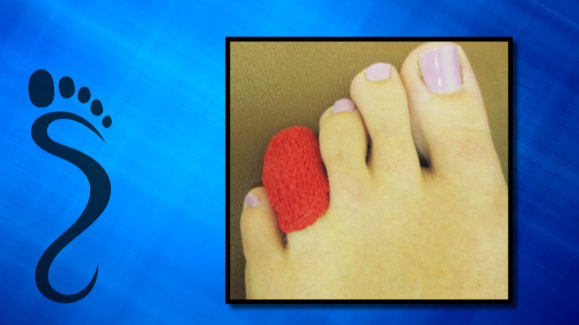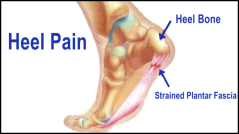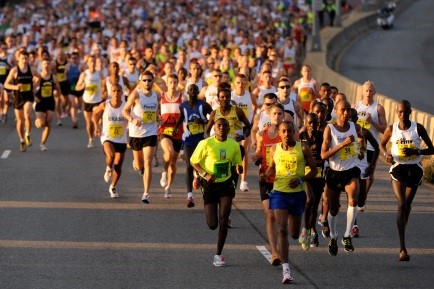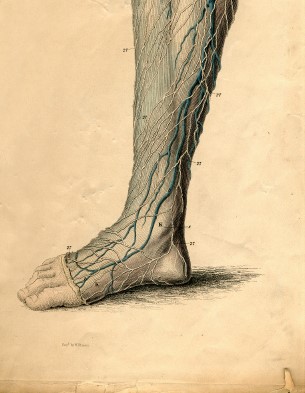Featured Articles
Items filtered by date: October 2014
UK Woman Confuses Plantar Warts for Corns
 Kelly Bradford found several lumps in her heels and first believed them to be corns due to their rough texture. The growths did not seem to be going away with the help of salicylic acid and were much more painful that corns usually are. When the growths became so painful that Bradford could not place her heels on the ground, she decided to contact her doctor.
Kelly Bradford found several lumps in her heels and first believed them to be corns due to their rough texture. The growths did not seem to be going away with the help of salicylic acid and were much more painful that corns usually are. When the growths became so painful that Bradford could not place her heels on the ground, she decided to contact her doctor.
Bradford’s physician concluded that she did not have corns and had contracted plantar warts. The pain she was more painful than anything she has experienced because the warts were pinching the nerves of her feet. With the help of some over-the-counter medication and cryotherapy, the warts in Bradford’s heels soon disappeared.
Plantar warts can be painful and can worsen if not treated properly. If you would like to be treated for plantar warts, consult with podiatrist Dr. Sharon Pletcher of Pennsylvania. Dr. Pletcher will attend to all of your foot and ankle needs and provide you with quality treatment.
About Plantar Warts
Plantar warts are found on the feet. These warts are caused by the human papillomavirus (HPV) getting into open wounds on the feet. You can recognize plantar warts by a hard bump on the foot. They are usually found on the heels or balls of the feet. Plantar warts are usually not a sign of anything dangerous but do not ignore them if they do cause pain or embarrassment.
If you do have a plantar wart, you may notice some pain when standing but since these warts are not cancerous or dangerous, a podiatrist only needs to be seen if there is excess pain. Although plantar warts don’t often call for treatment, there are options available. They can be frozen off, removed by an electric tool or burned off using laser treatment.
Home remedies are also available to help with plantar warts. An apple cider vinegar soak can help remove the wart. You can soak your feet in the vinegar for 20 minutes before using a pumice stone to remove any loose skin from the wart.
For more information about Plantar Warts, follow the link below.
If you have any questions, please contact our office located in State College, PA. We offer all the latest in diagnostic and treatment technologies to meet your needs.
Read more about Plantar Warts
About Plantar Warts
The term plantar means relating to the foot, which is why plantar warts are only found on the feet. Plantar warts are caused by the human papillomavirus (HPV) getting into open wounds on the feet. These warts are recognizable by a hard bump on the foot. They are mostly found heels or on the balls of the feet. Plantar warts are basically harmless, and may be ignored unless they cause pain or embarrassment.
If you have a plantar wart you may notice some pain when standing, or just some tenderness on the sole of your foot. You will be able to see a fleshy wart, unless it has grown into the foot behind a callus. Since plantar warts are not cancerous and not dangerous, a podiatrist only needs to be seen if there is excess pain, the warts come back often or persist for some time, or if it affects walking. It is extremely important that people suffering from compromised immune systems or diabetes seek out a physician’s care immediately upon finding a plantar wart on their foot.
Doctors can usually easily diagnose plantar warts. The doctor will scrape off a tiny bit of the rough skin to make tiny blood clots visible that make up the inside of these warts. If the doctor is unsure of a diagnosis they may do a biopsy to be certain. Though plantar warts don't often call for treatment, there are many options for combating them if need be. They can be frozen using liquid nitrogen, removed using an electric tool or burned using laser treatment. For a less invasive treatment a topical cream can be used which is available only through a prescription. Over the counter wart medications may help, given enough time and patience.
If you prefer to use home remedies an apple cider vinegar soak is believed to help remove the wart. This treatment takes time. Soak your infected foot in the vinegar for 20 minutes before using a pumice stone to remove any loose skin from the wart. Keep the wart covered for protection in between daily treatments.
The best way to avoid contracting plantar warts is to avoid walking barefoot in public areas. This includes wearing shoes in public showers also. It is also important to avoid direct contact with warts, as they can be contagious. This means not touching your own warts, as well as those on others.
Acupuncture Could Help Treat those Experiencing Heel Pain
 A recent study conducted by scientists at the Guangzhou Dongsheng Hospital has revealed that acupuncture is effective in treating heel pain. Xu Xuemeng, a researcher at Guangzhou, and his team used sixty-six patients that were experiencing heel pain. They gave some patients conventional drugs as a control group and gave the rest of the patients a filiform acupuncture needle treatment.
A recent study conducted by scientists at the Guangzhou Dongsheng Hospital has revealed that acupuncture is effective in treating heel pain. Xu Xuemeng, a researcher at Guangzhou, and his team used sixty-six patients that were experiencing heel pain. They gave some patients conventional drugs as a control group and gave the rest of the patients a filiform acupuncture needle treatment.
After six months, it was discovered that patients with acupuncture treatment had an effectiveness rating of 97% while the control group had a rating of 76%. Acupuncture has also been effective in alleviating the pain of conditions such as Achilles tendonitis and plantar fasciitis.
Anyone can wind up suffering from heel pain. If your heel is hurting, see Dr. Sharon Pletcher at Pennsylvania. We will treat your heel pain symptoms in addition to other podiatric-related needs.
Causes of Heel Pain
- Heel pain is often associated with plantar fasciitis. The plantar fascia is a band of tissues that extends along the bottom of the foot. A rip or tear in this ligament can cause inflammation of the tissue.
- Achilles tendonitis is another cause of heel pain. Inflammation of the Achilles tendon will cause pain from fractures and muscle tearing. Lack of flexibility is also another symptom.
- Heel spurs are another cause of pain. When the tissues of the plantar fascia undergo a great deal of stress, it can lead to ligament separation from the heel bone, causing heel spurs.
Why Might Heel Pain Occur?
- Wearing ill-fitting shoes
- Wearing non-supportive shoes
- Weight change
- Excessive running
Treatments
Heel pain should be treated as soon as possible for immediate results. Keeping your feet in a stress free environment will help. If you suffer from Achilles tendonitis or plantar fasciitis, applying ice will reduce the swelling. Stretching before an exercise like running will help the muscles. Using all these tips will help make heel pain a thing of the past.
With the advancements in technology and greater knowledge of how muscles and joints work, physical therapists can turn things around dramatically.
If you have any questions, please feel free to contact our office in State College, PA. We offer the newest diagnostic and treatment technologies for all your foot care needs.
Read more about Heel Pain
Fitness Based Smartphone App Creates Healthy Competition Among Employees
 Thanks to innovative smartphone apps and sensors such as the Fitbit, employees of Washington, D.C. have a found a new competition in how many steps to take a day. Lawmakers and administration officials are use this form of technology to track the employees’ steps, miles, calories burned, and heart rate.
Thanks to innovative smartphone apps and sensors such as the Fitbit, employees of Washington, D.C. have a found a new competition in how many steps to take a day. Lawmakers and administration officials are use this form of technology to track the employees’ steps, miles, calories burned, and heart rate.
In addition, many employers now hold office-held competitions which helps employees make the doctor recommended amount of 10,000 steps per day. “The type of people you find on Capitol Hill are very competitive by nature,” Alexa Marrero says, “You have a bunch of Type A personalities in jobs prone to keeping you behind a desk all day, so there are a lot of people who have found this as a fun way to get up.”
Walking is a tried and tested way to successfully exercise the feet. To learn more, consult with podiatrist Dr. Sharon Pletcher of Pennsylvania. Dr. Pletcher will answer any of your foot- and ankle-related questions.
Exercise for Your Feet
If you spend most of your time on your feet, or don’t either way your feet should deserve attention. There are many people who exercise regularly and still don’t spend enough time to care for their feet. Your foot does get exposure that requires maintenance since your health has a lot to do with footing.
Exercises
Toe rise – this exercise involves standing on the tip-toes for a count of 15 seconds, then resting your feet on ground. This exercise should be repeated three times a day to strengthen the feet.
Toe Pick-ups – the toes are exercises that are done by picking up small items using your toes. This helps strengthen the muscles on the upper part of the feet. Three sets along with 15 seconds being held should be completed. Small items like marbles or stationary will work.
Ankle Pump – can be performed upwards or downwards. The workout can be completed both ways at the same time. This involves flexing the foot either towards the shin or to the ground. This makes the foot work very well, working large parts of the muscles.
For more information about Exercise for Your Feet, follow the link below.
If you have any questions, please feel free to contact our office located in State College, PA. We offer the newest diagnostic and treatment technologies for all your foot care needs.
Read more about Exercise for Your Feet
Exercise for Your Feet
Whether your feet are over-worked or under-worked, chances are they could benefit from some special attention. Even those who exercise regularly probably do not spend any time strengthening their feet. This can be just as rewarding as strengthening the rest of the body, since the health of your feet affects the health of the rest of the body as well, especially the ankles, legs, and spine.
For those who might not have any idea on how a foot-specific exercise might be conducted, there are several workouts that are fairly easy to perform in the comfort of ones’ home. One of the easiest is the toe rise, also known as the tip-toe. This exercise involves standing on the tip-toes for a count of 15 then resting the feet on the ground. This process should be repeated a minimum of three times a day in order to strengthen the feet.
Toe pick-ups strengthen the feet by working them in a very different way. In this exercise, small items are picked up using the toes in order to strengthen the muscles on the upper part of the feet. Once again three sets should be performed, with the item in question being held for 15 seconds then dropped. Items that may be picked up using the feet include marbles and even stationery, which works wonders for the toes and the surrounding muscles.
Yet another simple workout is the ankle pump. This can be done either upwards or downwards, but for the workout to be most effective both can be incorporated into the routine. As the term suggests, this involves lifting the foot off the floor and flexing the toes either towards the shin or towards the ground. This movement puts the feet and ankles through a large range of motion which works muscles.
Last but not least, feet should be stretched so that the muscles can relax and recuperate. This can be done by placing both feet of the floor and bracing oneself against the wall at a 45 degree angle. This ensures that the feet and ankles are adequately stretched once the workout is complete.
In short, giving the feet a good workout every now and then is important in order to avoid problems such as plantar fasciitis, as well as to warm-up or cool-down after running or vigorous walking. Foot exercises may be followed by a good foot massage which encourages circulation in the feet as well as muscle relaxation.
Dark Chocolate Helps Patients With Circulation Difficulties
An interesting shows that dark chocolate polyphenols may help when it comes to symptoms of peripheral artery disorder (PAD). Sapienza University scientists gathered 20 participants for this study. The subjects were provided either dark chocolate or milk chocolate.
shows that dark chocolate polyphenols may help when it comes to symptoms of peripheral artery disorder (PAD). Sapienza University scientists gathered 20 participants for this study. The subjects were provided either dark chocolate or milk chocolate.
After eating the chocolate the subjects were instructed to walk on treadmills for a set time. As the scientists monitored the patients, they found that patients who ate dark chocolate experienced better circulation and were able to walk 10% farther than those who had eaten the milk chocolate.
Poor circulation is difficult to live with. If you have poor circulation in your feet or ankles, consider calling podiatrist Dr. Sharon Pletcher of Pennsylvania. Dr. Pletcher can treat your podiatric needs.
Poor Circulation in the Feet
Poor blood circulation in the feet and legs is caused by peripheral artery disease (PAD), which is the result of a buildup of plaque in the arteries.
Plaque buildup or atherosclerosis results from excess calcium and cholesterol in the bloodstream. It usually restricts the amount of blood which can flow through the arteries. Poor blood circulation in the feet and legs are sometimes caused by inflammation in the blood vessels, known as vasculitis.
Causes
Lack of oxygen and oxygen from poor blood circulation restricts muscle growth and development.
It can also cause:
-muscle pain -numbness in legs
-cramps -skin discoloration
-weakness -slower nail & hair growth
-stiffness -erectile dysfunction
Those who have diabetes and or smoke are at greatest risk for poor circulation, or who are over 50.
If you have poor circulation in the feet and legs it may be caused by PAD, and is important to make changes to your lifestyle in order to reduce risk of getting a heart attack or stroke. Exercise and maintaining a healthy lifestyle will dramatically improve conditions.
If you have any questions, please feel free to contact our office located in State College, PA. We offer the newest diagnostic and treatment technologies for all your foot care needs.
Read more about Poor Circulation in the Feet
Causes, Symptoms, and Treatment of Poor Blood Circulation in the Feet
Poor blood circulation in the feet and legs is often caused by peripheral artery disease (PAD), which is usually the result of a build up of plaque in the arteries. Plaque build up, or atherosclerosis, can be the result of excess calcium and cholesterol in the bloodstream, which restricts how much blood can flow through arteries. Reduced blood flow to a certain area of the body severely limits the amount of oxygen and nutrients that part of the body receives, causing degeneration in the muscles and other tissues. Sometimes, poor blood circulation in the feet and legs can be caused by other conditions, such as damage to or inflammation of blood vessels, known as vasculitis.
The lack of oxygen and nutrients caused by poor blood circulation can restrict muscle growth and development, as well as cause muscle pain and cramps, weakness, and stiffness. Other common symptoms include numbness in the legs and feet, skin discoloration in the affected limbs, slower nail and hair growth, and erectile dysfunction in men. In more severe cases of PAD, pain can be present even when a person isn't exercising, and may range from mildly uncomfortable to completely debilitating.
Poor blood circulation in the feet and legs is more common in those who are overweight or obese, have diabetes, high blood pressure, high cholesterol, who smoke, or who have a family history of PAD or related conditions (heart attack, stroke, etc.). Diabetes and smoking place a person at greatest risk for developing poor blood circulation, although advanced age (over 50) can also increase risk.
If you are experiencing poor blood circulation in the feet and legs caused by PAD, it is important to make changes to your lifestyle in order to reduce your risk of experiencing a heart attack or stroke caused by this condition. If you smoke, quit completely -- this will increase the amount of oxygen in your bloodstream. Exercising and reducing the saturated fats in your diet (which come from fatty meats, fried foods, whole milk, etc.) can make a difference in improving blood circulation in feet. It is also important to avoid developing influenza and to carefully control your blood sugar if you have diabetes.
Your doctor may recommend combining lifestyle changes with a prescription medication regimen to improve blood circulation. The most commonly-used medications for PAD are called statins and work by blocking the amount of enzymes in your body that produce cholesterol. They are known by the brand names Zocor, Lipitor, Crestor, and others.




